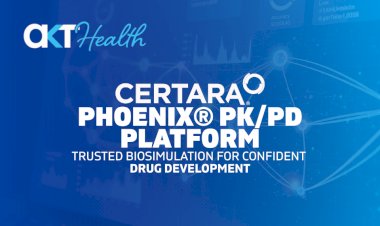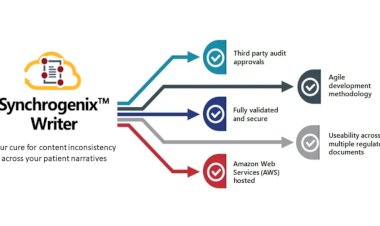Blockchain-Hyperledger framework for clinical trials
It's fundamental to have a unique blockchain design for specific industry use cases such as finance, insurance, supply chain, and healthcare. Most biomedical and healthcare applications require stakeholders as the most accepted participants for blockchain frameworks developed on private networks.

It's fundamental to have a unique blockchain design for specific industry use cases such as finance, insurance, supply chain, and healthcare. Most biomedical and healthcare applications require stakeholders as the most accepted participants for blockchain frameworks developed on private networks. With things like cryptocurrencies for participation, they don't need a momentum. Some are the result of Hyperledger, the popular private blockchain in Ethereum.
Applications on the private blockchain are ideal for secure data collection, management, and sharing within healthcare organizations. In the case, based on the Ethereum platform, a private blockchain framework builds MedRec and uses this blockchain network to share electronic medical records between patients and healthcare providers.
Medical applications can use private blockchains to securely collect, manage, and share data. For example, MedRec, a distributed data management system based on Ethereum's private network, can share electronic medical records between patients and healthcare providers. The author used Ethereum for the secure analysis and management of medical sensors. Built on Hyperledger Fabric, the Orange Consent Management System provides a consent management system for users to share their health data. In this article, the authors used Hyperledger Fabric to develop a distributed framework for consent management and secondary use of research data. The article also showed how to leverage smart contracts to enforce IRB regulations.
Hyper leisure
The Linux Foundation has developed the Hyperledger Fabric framework. It is a private blockchain network that provides a modular architecture by supporting pluggable components such as consensus protocols, encryption, identity management, membership services. A private network consists of multiple nodes, chain code (business logic), and a ledger that contains a state database and transaction logs. Nodes can be managed by individual users or by multiple users. Based on the capabilities of Hyperledger, nodes can be categorized as Clients (calling transactions), Peers (maintaining and updating ledgers), and Audlers (supporting communication and maintaining transaction order).
Client node: Connected to both peer node and orderer node. It sends a call to the transaction to the endorser and a proposal to the transaction to the buyer.
Peer node: Its role is to commit transactions and maintain the state of the ledger world. Update the ledger after receiving the order status from the orderer.
Ordering node: Creates a broadcast communication service to guarantee delivery. After validating the approval message, deliver the transaction to the peer node.
Also known as Hyperledger Fabric chain code, smart contracts are self-executing logic that represent an agreement or set of rules governing transactions within a blockchain network. Rules are implemented as a function of chain code. Every data transaction that needs access to the ledger calls the corresponding chaincode function. Hyperledger Fabric implements an approved policy or condition to validate a proposed transaction. When a transaction is proposed by a client, it must be approved by a predefined approval node. Recommended signatures will be collected and sent to the orderer. The orderer verifies approval messages from all approvers, including a valid number of approver signatures and simulated transaction results. Collected transactions are sent as a new block to all peers. A Trusted Membership Service Provider (MSP) registers network participants. MSPs provide verifiable digital identities to all entities within the blockchain network, including peers, orders, and clients. It acts as a trusted authority that abstracts the process of issuing cryptographic certificates and user authentication. Other notable features of Hyperledger Fabric include:
Confidentiality: In addition to private networks, you can create private channels that consist of subgroups of network participants. All information related to a channel is only accessible to members of that channel, increasing the level of confidentiality.
Encrypted Identity Management: Membership Identity Service manages user identities and authenticates all participants on the network. You can implement additional access controls for specific network operations.
Modular design: Supports a modular architecture that plugs and plays various components such as membership features and consensus.
Blockchain network setup
It is important in the blockchain to identify the stakeholders or participants and their roles before starting the network setup. For multi-site clinical trial protocols, it is most important to recruit the following personnel to conduct a multi-site clinical trial.
Subject— An individual who a researcher collects data to conduct a research study. Data can be collected by intervention or interaction with each
Investigator (PI) — Investigator — The principal individual responsible for study preparation, conduct, and management at each site of a multicenter clinical trial. While maintaining ethical behavior and research supervision. Protect the rights, safety, and well-being of subjects enrolled in the trial. Access to data and samples collected from subjects, analysis results, adverse event cases, and research reports.
Coordinating Center (CC) —Center for coordinating multisite clinical trials. Create data compilation reports, subject activity schedules and communicate them to the appropriate stakeholders. It maintains a central database that also stores SAS data.
Data Security Oversight Board (DSMB ) — an independent expert who regularly reviews and evaluates accumulated research data on participant safety and research progress, and makes recommendations for continuing, modifying, or terminating studies. group.
Institutional Review Board (IRB) — A designated committee to protect the rights, safety, and health of subjects participating in clinical trials. They review all aspects of the test, including the approval of test materials before and during the test. NIH's new policy requires a single IRB (sIRB) to conduct an ethical review of multisite research.
Regulatory Agency— A regulatory agency such as the Food and Drug Administration (FDA) ensures that the medical care used by a subject is safe and effective. Testing of the research site protects the subject's rights and verifies the quality and integrity of the data.
Sponsor—A person, institution, or organization that initiates, manages, and funds clinical trials, but does not actually conduct them.
Analyst— A researcher or statistician who collects, reviews, and organizes study results, including unidentified data collected from subjects.
Each person involved in the multi-site clinical trial considers it to be a node in the blockchain network. A node can represent an individual (PI), an institution (target institution), or an organization (sIRB). In a standard blockchain network, each node maintains a single ledger and operates on a smart contract. Smart contracts implement pre-approved research protocol guidelines, including how to collect, store, and share test data. Raw data can be saved directly to the ledger. However, for large data such as wearable sensor readings and genomic data, it is recommended to store it off-chain with an encrypted key that links to your ledger.
Creating a private channel
Hyperledger Fabric provides an additional level of data privacy by incorporating private channels between a subset of members in the network. The network supports multiple channels, each maintaining a separate smart contract and ledger. Ensures confidentiality by making all data, including transactions, ledgers, members, and channel information visible and inaccessible to members who are not explicitly granted access to that channel. These lightweight channels further reduce the storage space and energy consumption required to maintain a blockchain network. Multiple channels increase transaction throughput by allowing transactions to run in parallel. Multi-site clinical trials will incorporate private channels to streamline data flow and limit data access to designated personnel. Divide the network into the following private channels:
Subject Enrollment Channel: Once a subject is determined to be eligible to participate in a clinical trial, PI will collect data including consent and protected health information (PHI) for enrollment. This channel corresponds to the clinical trial consent management system. Create a private channel to manage registration-specific information so that only the intended members of the blockchain network can access such sensitive data. This includes PIs, subjects, coordination centers, and DSMBs.
Trial Monitoring Channels: Raw data or samples are regularly collected by trial sites or clinics when a subject agrees to participate in the study. Create separate channels including PIs, DSMBs, sponsors, coordinating centers and regulators to monitor the activities performed in the trial. Members of this channel have access to research data collected from subjects, activities performed at each visit, study results, and cases of adverse events experienced during the study.
Data analysis channel: Analysts perform analysis of unspecified data to gain insight into the effectiveness of their research. Create a data analysis channel between your PI and analysts to allow secondary sharing of anonymized data for analysis.
A blockchain-based system with a private channel for managing data in multi-site clinical trials. Each participant maintains a ledger and operates on its member channel's smart contracts. It further restricts unauthorized data access by maintaining confidentiality of information, restricting access to channels, and restricting data transactions to channel members.
Research Report Channel: The Clinical Research Report is a detailed document that describes the study method and results. Integrate clinical and statistical explanations, presentations and analyze results. A private channel consisting of PIs, sponsors, regulators, coordinating centers, and subjects helps manage and share research reports.
Therefore, in this framework, each node maintains a ledger for each member channel, rather than a single ledger containing the entire trial data. The transactions within each channel are further managed by their own smart contract. The proposed system design is based on the NIH-funded multisite clinical trial protocol, but can be extended to meet the specific requirements of other studies.
Implementing channel-specific smart contracts
Smart contracts are essential for implementing and implementing the clinical trial protocol 4 guidelines. These programs can define a list of features that incorporate specific requirements for conducting clinical trials. Blockchain participants can interact with the application interface to invoke the functionality of the smart contract. For each data transaction request, the corresponding function validates whether a valid user has suggested a valid channel, data type, and time. This allows fine-grained access control. Here we provide a detailed description of the smart contracts specific to the above private channel.
Enrollment Smart Contracts: Each clinical trial protocol defines a set of inclusion and exclusion criteria that determine whether a candidate is eligible to participate in the study. This often requires checking the candidate's age, gender, preconditions, and past treatment. The registration feature within the smart contract can check a set of constraints before registering candidates and adding data to the ledger. Since PI is responsible for data anonymization, it can trigger a smart contract function that disassociates the clinical information from the subject's identifiable information. During registration, all sensitive information collected from subjects, such as PHI and consent information, can be stored in the ledger. Smart contracts can further see if the target member is trying to call a particular function. For example, the subject can attempt to read the data stored by the PI on the ledger. Similarly, members of the DSMB can have read or write access to this ledger. Limiting access to such sensitive information to designated members of your network further increases the privacy of your data. If approved, the subject's record will be added to the ledger.
Trial Monitoring Smart Contracts: The Trial Monitoring channel collects and manages various types of data during the trial. In a multi-site research study, each clinic will carry out a given set of activities based on a protocol-defined schedule of activities. This includes collecting questionnaires or samples from subjects, conducting laboratory tests, and reporting adverse events. This channel-specific smart contract can check if the data corresponding to the scheduled activity was entered into the system during the approved timeline. In addition, you can check whether certain prerequisites have been met before you enter the data. With current clinical trial management systems, it is often difficult to timely report cases of adverse events or laboratory abnormalities, so smart contracts can be used to record, track, and update these events in real-time. .. In addition to rapid intervention, it provides regulators with a transparent and reliable event monitoring approach. In addition, smart contracts flag transactions and record them in the immutable transaction log when attempts are made to distort or tamper with the recorded data. In multi-site trials, this framework ensures the origin and quality of data collected from different sites. Implementing a single smart contract at all sites further ensures compliance with IRB-approved research protocols and a consistent data framework.
Smart contracts for data analysis: Anonymized data collected from subjects will be shared with analysts for secondary data analysis. By combining the above consent management system and smart contracts, unauthorized data access is restricted even for the most restrictive comprehensive consent. The smart contract checks the consent information stored in the ledger to validate the request. If approved, anonymized data in SAS format will be shared. Secondary studies include topics such as longitudinal data analysis, subgroup analysis, non-linear relationships, and meta-analysis. Based on the underlying programming language, smart contracts can call further modules or functions that automatically execute the analytic code.
Research Report Smart Contract: The Clinical Research Report is an integrated report that includes clinical, statistical explanations, presentations, and analysis. Also included are sample case report forms, research product-related information, technical statistics documents, patient data listings, and technical statistics details28 such as derivations, calculations, analyses, and computer output. Designed for this channel, smart contracts automatically generate audits to access transaction logs and assess participating site performance, protocol compliance, and exam effectiveness. This can significantly reduce the burden of manual auditing and selective, underreporting, and false reporting incidents. This also applies to the regular generation of reports for ongoing review. This will improve the credibility and completeness of research reports submitted to regulatory authorities.
Protocol revisions are frequent in clinical trials, with an average of 2.3 revisions per trial. If a fix is unavoidable, it is important to perform and track the fix across all participating sites and stakeholders. To implement such a fix in the framework, the channel-specific smart contract must be updated so that all interested parties are aware of and comply with the update. This is accomplished by a special high-level system chaincode that incorporates and tracks updates made to the channel-specific chain code. To ensure transparency, design, and validate your authorization policies before you start updating your smart contracts.
Evaluation
Evaluate the effectiveness of the proposed data management system in implementing the key requirements of the NIH-funded multicenter clinical trial.
Audit Trail: As noted in the National Institute on Drug Abuse (NIDA) Clinical Trials Network (CTN) Guide for Conducting High-Quality Studies, appropriate documentation of how research procedures are conducted is always required .. Maintaining an audit trail includes reports on regular monitoring of survey sites, confirmation of survey compliance, and visit monitoring. Current systems rely on manual labor to record and maintain documents, resulting in staff turnover or unplanned emergencies. The blockchain maintains an immutable log of data transactions and recorded activity, eliminating the need for paper-based trails. Attempts to tamper with encrypted secure transactions will automatically be flagged and reported. This strict standard for research supervision improves the traceability and fidelity of research.
Data Privacy: Unlike traditional systems, the private blockchain framework with private channels provides a high degree of data privacy. As mentioned earlier, blockchain and smart contracts enable secure consent management and secondary data sharing. PI can use the system to anonymize data, store sensitive information in a ledger, and use an encrypted key to store anonymized data in a database. Based on the consent information stored in the ledger, third-party researchers use one-time encryption keys to access anonymized data. This limits access to the data if the privilege is revoked. Smart contracts further limit the use of malicious data with fine-grained access control. You can grant individuals access to data for specific data types and time periods. Private channels enhance data privacy without impacting transaction efficiency. Recent research has shown how a multi-channel setup can improve transaction throughput by allowing multiple independent transactions to run concurrently.
Data integrity: The source and integrity of the data ensure the validity of the study and its results. Data collection and reporting must follow approved guidelines and standardized language. This is especially relevant for multi-site studies where raw data, surveys, and lab reports are collected and managed by multiple participating sites and their personnel. Distributed systems like blockchain facilitate data entry. It is time-stamped and is almost impossible to forge if it exists on your system. This automatically strengthens the trust of the system without the need for a central, trusted authority. To enhance data integrity and consistency across all sites, the smart contract feature defines and validates a set of criteria that must be met before data entry. Prior to data entry, you can check whether eligibility criteria such as inclusion and exclusion criteria are met, whether the site is scheduled for an activity for each visit and whether it complies with data standards such as HL7 and SNOMED CT. This will reduce the cases of data fraud or inconsistencies that are typically found later in the exam.
Protocol violations: Protocol violations reduce profits, increase risk, and affect subject safety and well-being and data integrity. Once a clinical trial protocol is approved using the current clinical trial management system, it is difficult for all sites and staff to ensure compliance. Smart contracts can verify that certain constraints required by the protocol are met. This includes, but is not limited to, insufficient informed consent, subject enrollment criteria, false or underreported events. With constraint checking and automatic monitoring, the smart contract feature detects and records protocol violation cases. In addition, it assists in automatically generating reports to notify regulatory agencies such as DSMB and IRB of such incidents. Accurate and timely reporting of protocol violations is essential for interpreting the results and designing safety assessments after approval of new interventions.
Protocol modifications: Modifications of clinical trial protocols are difficult for data analysis and interpretation, especially if they occur in the middle of the trial and may introduce bias when changes are made based on trial data. there is. Implementing and communicating the amendments can be burdensome and costly. Once the protocol is revised, all sites must adopt and comply with the updated guidelines. Smart contracts that implement the protocol guidelines are updated upon approval from the appropriate members and are installed on all nodes to enforce the updated guidelines and ensure consistency. If the fix requires a channel-specific smart contract update, all other channels can continue to work with the existing version. Therefore, the framework not only provides a transparent approach to version control, but also a modular design for implementing fixes.
Adverse Event Reporting: In order to meet its obligations during the conduct of a clinical study, the IRB must-have information on unexpected issues, including risks to human subjects in the study, including adverse events that are considered unexpected issues. I won't. Failure to report or delay reporting of adverse events can seriously impact subject safety and well-being, study results, and study effectiveness. Adverse event reporting is a multi-step process, often delayed due to manual intervention and the lack of a sophisticated approach to reporting. Smart contract capabilities triggered by the research coordinator, PI, or affected subject enable real-time, automated reporting of adverse events and facilitate intervention. These features can also confirm if the follow-up survey for evaluation has been completed. Access transaction logs to easily track and monitor harmful events. Such an approach enables the timely identification of adverse events and response to patient safety.

 Meghana
Meghana 

































